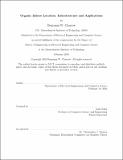| dc.contributor.advisor | Seth Teller. | en_US |
| dc.contributor.author | Charrow, Benjamin W | en_US |
| dc.contributor.other | Massachusetts Institute of Technology. Dept. of Electrical Engineering and Computer Science. | en_US |
| dc.date.accessioned | 2011-02-22T15:37:38Z | |
| dc.date.available | 2011-02-22T15:37:38Z | |
| dc.date.copyright | 2010 | en_US |
| dc.date.issued | 2010 | en_US |
| dc.identifier.uri | http://hdl.handle.net/1721.1/61005 | |
| dc.description | Thesis (M. Eng.)--Massachusetts Institute of Technology, Dept. of Electrical Engineering and Computer Science, 2010. | en_US |
| dc.description | This electronic version was submitted by the student author. The certified thesis is available in the Institute Archives and Special Collections. | en_US |
| dc.description | Cataloged from student-submitted PDF version of thesis. | en_US |
| dc.description | Includes bibliographical references (p. 55-57). | en_US |
| dc.description.abstract | We describe OIL, a system that uses the existing wireless infrastructure of a building to enable a mobile device to discover its indoor location. One of the main goals behind OIL is to enable non-expert users to contribute the data that is required for localization. Toward this we have developed (1) a server-client architecture for aggregating and distributing data; (2) a caching scheme that enables client devices to estimate indoor location; (3) a simple user interface for contributing data; and (4) a way to indicate how uncertain localization estimates are. We evaluate our system with a nine-day, nineteen-person user study that took place on campus as well as a deployment of the system at an off-campus long-term specialized care facility. We also describe how to use a person's indoor location trace (i.e. the rooms they had visited and the times of each visit) to build a content-based recommendation system for academic seminars. Such a system would learn about a user's preferences implicitly, placing no burden on the user. We evaluate a prototype recommendation system based on data gathered from a user study in which participants ranked seminars. | en_US |
| dc.description.statementofresponsibility | by Benjamin W. Charrow. | en_US |
| dc.format.extent | 57 p. | en_US |
| dc.language.iso | eng | en_US |
| dc.publisher | Massachusetts Institute of Technology | en_US |
| dc.rights | M.I.T. theses are protected by
copyright. They may be viewed from this source for any purpose, but
reproduction or distribution in any format is prohibited without written
permission. See provided URL for inquiries about permission. | en_US |
| dc.rights.uri | http://dspace.mit.edu/handle/1721.1/7582 | en_US |
| dc.subject | Electrical Engineering and Computer Science. | en_US |
| dc.title | Organic indoor location : infrastructure and applications | en_US |
| dc.type | Thesis | en_US |
| dc.description.degree | M.Eng. | en_US |
| dc.contributor.department | Massachusetts Institute of Technology. Department of Electrical Engineering and Computer Science | |
| dc.identifier.oclc | 702369006 | en_US |
